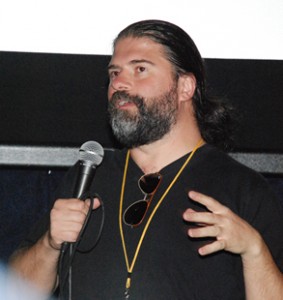LA Film Fest – ‘Europa Report’
(First published on blogcritics.org)
Europa Report is “hard” sci-fi. That means that its plot cannot be separated from the science involved. This distinguishes it from, for instance, the original Star Wars, which I love, because the plot of Star Wars could be easily moved to a pirate ship, the old west or WWII. Does that mean Europa Report is nerdy or boring? Absolutely not.
Europa Report, as part of the LA Film Fest Summer Showcase, made its U.S. premiere June 19,2013. After the film director Sebastian Cordero answered questions from the audience. This was Ecuadoran Cordero’s first English language, and first sci-fi, effort. No one would have guessed. Cordero explained that they tried very hard to “get the science right.” The science involves a privately funded space ship, with an international crew, traveling to Europa, a moon of Jupiter, in order to determine if signs of water and life uncovered by long distance monitoring were accurate. To insure they were scientifically on track, Cordero sought and received advice from JPL, NASA and SpaceX. These efforts resulted in a film that should appeal to sci-fi fans and scientists. The international crew of the spacecraft is played by an international cast, including Michael Nyqvist (The Girl with the Dragon Tattoo, Mission Impossible – Ghost Protocol), Sharlto Copley (District 9, The A-Team), Embeth Davidtz (The Amazing Spider-Man, The Girl with the Dragon Tattoo), Daniel Wu (The Man with the Iron Fists, Protégé), Christian Camargo (Dexter, The Hurt Locker), Karolina Wydra (True Blood, Crazy Stupid Love), and Anamaria Marinca (Palme d’Or winner 4 Months, 3 Weeks and 2 Days).
Cordero said that getting them all together in New York at once for the shoot didn’t leave much time for rehearsal. Looking at the end product, this was not a problem. The portrayals are memorable, realistic and make one think about the kinds of people and sacrifices needed to push the bounds of human knowledge into the heavens.
 The conceit of the film is that you are watching a report by the private company that financed the project and all of the video of the crew are from the on-board cameras. We sometimes see multiple screens at once, video interference, and usually dates and times included in the in-flight videos. The technique adds to the reality. Other “reality” aspects are TV news reporting, and the video report by the head of the company sponsoring the flight.
The conceit of the film is that you are watching a report by the private company that financed the project and all of the video of the crew are from the on-board cameras. We sometimes see multiple screens at once, video interference, and usually dates and times included in the in-flight videos. The technique adds to the reality. Other “reality” aspects are TV news reporting, and the video report by the head of the company sponsoring the flight.
Codero explained that this was actually how most of the film was shot. “We built the sets on a soundstage, then, because the cameras were all around the inside of the simulated spacecraft, we’d close the doors. The cast was as isolated as the crew would have been. I directed from outside. They couldn’t see me, so that was a challenge. I was like ground control,” he said. Not all the scenes were inside the spacecraft. The shots of extravehicular activity were impressive, too.
Another aspect of the film that was intriguing was that the story was told non-sequentially. Several times during the film, I thought to myself, “Now, I get it. I know what’s going to happen.” I was wrong.
I asked if the non-sequential presentation was planned from the start. Cordero answered, “No, the script by Philip Gelatt had a traditional structure. It was in the editing room that we decided on the non-linear approach.”
For you hard core sci-fi fans, you’ll appreciate the brief homage to 2001: A Space Odyssey and, yes, there are tentacles. Europa Report, PG-13, is available on Amazon Instant Video, and in theaters in select markets in August. I’d wait and try to see it on the big screen.



